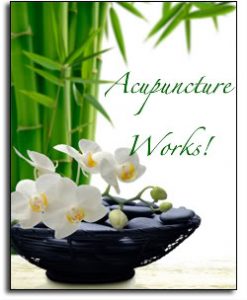What Is Acupuncture?
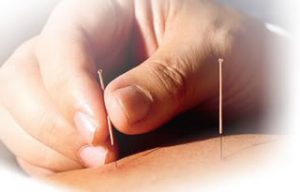
Acupuncture literally means ‘needle piercing,’ the practice of inserting very fine needles into the skin to stimulate specific anatomic points in the body (called acupoints or acupuncture points) for therapeutic purposes.
This activates the body’s qi and promotes natural healing by enhancing recuperative power, immunity, and physical and emotional health. It can also improve overall function and well being. It is a safe, painless and effective treatment for many different health conditions, disorders, and a wide variety of medical problems. Acupuncture has also proven to be an invaluable tool in helping people to prevent future health problems.
How does Acupuncture work?
Acupuncture works with the natural vital energy inherent within all living things to promote the body’s ability to heal itself. Acupuncture is based on an energetic model rather than the biochemical model of Western Medicine. The ancient Chinese recognized a vital energy behind all life forms and life processes. They called this energy Qi. This energy flows through the body in channels known as meridians that both nourishes our tissues and connects our major organs. According to Oriental medical theory, illness arises when the cyclical flow of Qi in a meridian becomes unbalanced or is blocked, much like a dam blocking a river. This creates imbalance and pain. Stimulating acupuncture points influences the meridians, unblocks obstructions, and helps reestablish the regular flow of Qi through the meridians.
Acupuncture points are specific locations along the meridians. Each point has a predictable effect upon vital energy (Qi) passing through it, altering various biochemical and physiological conditions in order to achieve the desired effect. Modern science has been able to measure the electrical charge at these points, thus confirming the meridians mapped by the ancients.
A more scientific explanation of Acupuncture is that the stimulation of certain Acupuncture points on the body prompts the body to release certain hormones and chemicals that can reduce pain, regulate the endocrine system, and calm the nervous system. Acupuncture profoundly influences the central and peripheral nervous system directly, releases endorphins from the brain, affects blood sugar, cholesterol levels, and benefits the gastrointestinal system.
Some of the physiological effects observed throughout the body include increased circulation, decreased inflammation, relief from pain, relief of muscle spasm, and a strengthened immune system with increased T-cell counts. Acupuncture has a positive effect on the hypothalamus-pituitary gland, the gland that is responsible for releasing neurotransmitters & endorphins, the body’s natural pain-killing hormone.
Endorphins can have a strong pain reducing effect and also play a big role in the functioning of the hormonal system. This explains why Acupuncture works so well for pain relief.
Substances released as a result of Acupuncture not only relax the whole body; they regulate serotonin in the brain, which plays a role in a human’s psychological disposition. This explains the mood elevating effect of Acupuncture.
What Does Acupuncture treat?
We treat the person, not the disease, so really there is no limit to what acupuncture can treat.
The World Health Organization has issued a comprehensive list of diseases and conditions, which are treatable by acupuncture. Some of the more common conditions are:
Abdominal pain ,Constipation, Diarrhea, Hyperacidity, Indigestion, Anxiety, Depression, Insomnia, Nervousness, Neurosis ,Eye-Ear-Nose-Throat ,Cataracts, Gingivitis, Poor vision, Tinnitus, Toothache, Gynecological, Infertility, Menopausal symptoms, Premenstrual syndrome, Musculoskeletal, Arthritis, Back Pain, Muscle cramping, Muscle pain/weakness, Neck pain, Sciatica, Neurological, Headaches, Migraines, Neurogenic bladder dysfunction, Parkinson’s Disease, Post-operative pain, Stroke, Respiratory, Asthma, Bronchitis, Common Cold, Sinusitus, Smoking cessation, Tonsillitis, Addiction control, Athletic performance, Blood pressure regulation, Chronic fatigue, Immune system tonification, and Stress reduction.
Is Acupuncture safe? Is it Painful?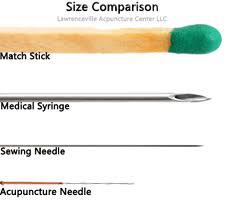
Becoming an Acupuncturist is a lengthy and arduous process. Your safety is assured in my trained hands. Acupuncture needles are extremely thin (about the width of a human hair), sterile, do not have a hollow center and are single use, properly disposed as biomedical waste.
Once I have made an assessment and chosen the acupuncture points to be used, treatment begins. The patient lies down on my comfortable table, each of the point locations are cleaned with an alcohol swab, and then a sterilized acupuncture needle is inserted and left for about 15-40 minutes.
Undergoing an Acupuncture treatment bears no resemblance to the feeling of receiving an injection. A Qi sensation is often described as a dull achy or heavy feeling with perhaps warmth or mild throbbing at a particular location. Patients are often surprised at how relaxing an Acupuncture treatment can be, and occasionally fall asleep during treatment. Many feel no insertion at all. My policy is to work with each patient to determine the level of sensitivity and to find alternative techniques when necessary.
While the needles are in place, you should not move suddenly. IF you should shift and the sensation increases, simply relaxing again should subside any unusual sensations. Relax. Breathe. Rest. Relax your body and mind and let the needles do their work. I will be available in the next room should you need anything adjusted.
Depending on patient preferences and indicated treatment protocols, massage, heat therapy, cupping, moxibustion, or various other techniques may be applied to achieve longer-lasting results in a shorter amount of time.
How long will sessions last? How often should I come?
The initial visit, including an intake will be 90-120 minutes. Subsequent visits last 60-70 minutes and the frequency of treatments will vary with each individual and their needs. Acute syndromes might need two to three treatments per week and typically change faster. A general protocol or chronic condition may take a course of sessions totaling ten or more and may be spaced with less frequency. You’re commitment to keeping appointments and maintaining doses of prescribed herbs and lifestyle recommendations will influence the rate and extent of your outcome. Once a patient realizes satisfactory results from the treatments, they are encouraged to continue with a seasonal maintenance schedule in order to stay in balance.
How should I prepare for an Acupuncture treatment?
Maintain good personal hygiene to reduce the risk of bacterial infection. Wear clothing that is loose and accessible (Being able to pull a shirt up or pants down when combined with draping makes it simpler than having to undress into a gown). Avoid tight stockings. Avoid treatment when hungry, overly full, emotionally upset, or shortly after sex.
What do I do after an Acupuncture treatment?
Be good to yourself. Relax and allow the treatment to settle into your system. Try to schedule your appointment so you do not have to rush around directly following. Refrain from eating a heavy meal directly following or exercising vigorously right away. A casual walk is fine, and may actually be a nice compliment to the session.
Auricular Therapy
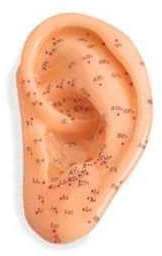 What Is Auricular Therapy?
What Is Auricular Therapy?
Auricular therapy is one of the most important components of Traditional Chinese Acupuncture. It is a specialized form where the ear is used to stimulate various organs and meridians in the body. The ear represents a fetus in the womb but in an inverted position. The ear is considered a “microsystem” of the body. “Microsystems” are like small images of your body, located in different locations on your body. Foot reflexology is also an example of a microsystem. If you have neck pain, you may feel relief when the neck area in your feet is stimulated. Other microsystems are located on the face, scalp, eyes, and hands.
How Does Auricular Therapy Work?
Based on extensive clinical research, there are three accepted theories which explain how auricular therapy works.
The Homuncular Reflex Theory (Anatomical Model) shows that the map of the location of auricular points is in the shape of an inverted fetus. Message transfer between auricular points and related body parts has been found to be bi-directional.The Delta Reflex Theory (Lock & Key) shows that stimulation of body parts causes a change in temperature of the related auricular point, and vice versa. In short, the ‘key’ of auricular stimulation can open the ‘lock’ of somatic ‘body’ response in the corresponding body parts.
A deeper look at Meridian Theory shows that energy travels along a system of pathways, neither vessels nor nerves, and converges at the ear. This is one of the most important aspects of Chinese auricular therapy.
Why Is It Ancient?
Auricular therapy has a long history in China. The earliest recorded mention of the close relationship between the ear and the body is found in the Silk Book Meridians, written around 500 B.C., which states that the ear meridian originates in the back of the hand and ascends to enter the ear. Auricular diagnostic and therapeutic methods were first documented in Nei Jing, The Classic of Medicine, written around 200 B.C., which stated that the nature and location of various diseases could be determined by inspection of the shape, color, moistness, and collaterals of the ear. It recommended the use of blood-letting puncturing of the collaterals of the ear to treat headache and side pain.
Later practitioners continued to develop the practical application of auricular diagnosis and to do research into the mechanisms of auricular therapy. During the Jin dynasty (265-420 AD), auricular massage was widely used to preserve health and to diagnose and treat various diseases and disorders. The use of auricular acupuncture and moxibustion was first recorded during the Tang dynasty (608-907 AD). During the Ming dynasty (1368-1644 AD), auricular medicinal coating came into use, and auricular massage for children was popular. During the Qing dynasty (1644-1911 AD), the use of auricular temperature measurement as a means of prognosis was recorded. This led to the creation of the first ear map and auricular massage chart which showed a relationship between some areas of the ear and body.
Why Is It New?
In 1946, an American scientist reported that there was some kind of relationship between congenital development of the kidney and the shape of ears, but it didn’t get people’s attention. In 1957, French practitioner Dr. Paul Nogier published his discovery that the distribution pattern of auricular points was related to the shape of an inverted fetus. After this information was published in China, it spread very fast and people combined Dr. Nogier’s theory with traditional Chinese medicine to develop Chinese Auricular Therapy. This new technique is characterized by diagnosis and treatment according to Chinese meridian theory. New points and treatment patterns have been discovered, and the function of both new and old points has been updated. In 1982, the World Health Organization (WHO) asked the Chinese Acupuncture & Moxibustion Association to formulate the International Standard of Auricular Points.
The development of modern science has led to the development of new treatment methods and equipment. Instead of just a couple of methods, there are now more than 15 ways to perform auricular therapy, including massage, electric stimulation, needles, moxa, seeds, magnets, laser etc. More methods give us more choices, making this form of acupuncture ideal for the young and old.
Auricular can be a ‘stand alone’ treatment, but I really like the combination of auricular & body needles for maximum efficacy.
I have assisted teaching the Auricular class 4 separate semesters & really promote their use.

Facial Rejuvenation Acupuncture
Facial Rejuvenation, also known as Cosmetic Acupuncture, is a painless, non-surgical method used to reduce the signs of aging. Though relatively new in the United States, Facial Rejuvenation has been practiced for thousands of years in China. At least as early as the Sung Dynasty (960 AD -1270 AD), acupuncture rejuvenation practices were employed, especially for royal families. A famous Chinese saying states: “Where qi flows, blood flows.” By stimulating the face with needles, the energy flow of the whole body is stimulated, allowing the person to not only to look better, but feel better as well.
F.R. is a safe and effective alternative to plastic surgery and Botox. Whereas Botox treatments numb the face and dull the energy flow, cosmetic acupuncture actually brings vitality and energy to the face, allowing for more elasticity and expression
The treatments address the physical, mental and emotional patterns that cause disease and contribute to the aging process. F.R. helps to alleviate fine lines, wrinkles, puffiness, sagging and discoloration of the skin, while simultaneously supporting overall health.
Treatments tighten the pores, improve muscle tone and dermal contraction, increase collagen production and affect its distribution. Tiny acupuncture needles are inserted into specific facial and body points, working to increase local circulation of blood and lymph, and stimulate the body’s natural processes of cell reproduction and growth.
Facial Rejuvenation truly works from the inside out, utilizing the body’s own systems to re-energize and re-vitalize, helping bring the beauty from within back to your appearance.
Benefits of Facial Rejuvenation Acupuncture may include:
- Delays facial aging
- Reduces fine lines, wrinkles, age spots
- Minimizes ‘crows feet’ around the eyes
- Tightening of the pores
- Lifts sagging skin and drooping eyelids
- Increases collagen production
- Improves muscle tone
- Reduces dark circles and puffy eyes
- Brightens the eyes
- Improves hormonal balance to reduce acne
- Improves elasticity of facial muscles
- Restores a youthful glow
- Reduction of sagging and jowls
- Improvement of facial color through increased circulation
- Moistening of the skin through increased circulation to the face
- Lifting of drooping eyelids
- Reduction of stress evident in the face
- Emergence of one’s innate beauty and radiance
Protocol
This is typically done in a 12-treatment protocol. Treatments are scheduled once or twice a week. Results last from 3 to 5 years.
Invest in your younger looking, beautiful face!
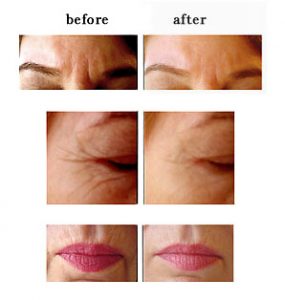
Injection Therapy
Injection Therapy (also known as biopuncture therapy) is the same as normal intramuscular injection and subcutaneous injection as far as how they are administered. However, they differ in the location of the body where they are administered. Homeopathic injections such as Traumeel are administered in Acupuncture and trigger points throughout the body depending on the condition treated or area of the body that is injured.
Traumeel is a natural anti-inflammatory alternative to cortisone shots. Because of the nature of homeopathic remedies, there is no limit to the usage of these injections, it does not interfere with other treatments, and it does not have side effects
